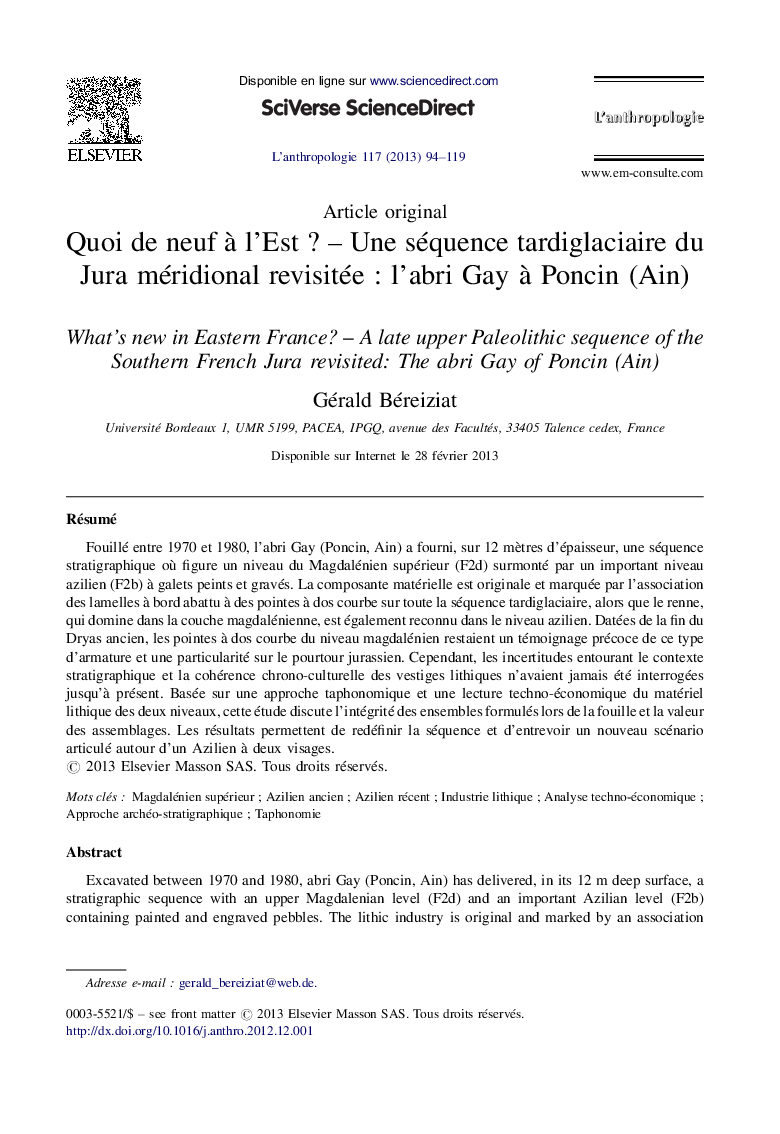| Article ID | Journal | Published Year | Pages | File Type |
|---|---|---|---|---|
| 1033716 | L'Anthropologie | 2013 | 26 Pages |
RésuméFouillé entre 1970 et 1980, l’abri Gay (Poncin, Ain) a fourni, sur 12 mètres d’épaisseur, une séquence stratigraphique où figure un niveau du Magdalénien supérieur (F2d) surmonté par un important niveau azilien (F2b) à galets peints et gravés. La composante matérielle est originale et marquée par l’association des lamelles à bord abattu à des pointes à dos courbe sur toute la séquence tardiglaciaire, alors que le renne, qui domine dans la couche magdalénienne, est également reconnu dans le niveau azilien. Datées de la fin du Dryas ancien, les pointes à dos courbe du niveau magdalénien restaient un témoignage précoce de ce type d’armature et une particularité sur le pourtour jurassien. Cependant, les incertitudes entourant le contexte stratigraphique et la cohérence chrono-culturelle des vestiges lithiques n’avaient jamais été interrogées jusqu’à présent. Basée sur une approche taphonomique et une lecture techno-économique du matériel lithique des deux niveaux, cette étude discute l’intégrité des ensembles formulés lors de la fouille et la valeur des assemblages. Les résultats permettent de redéfinir la séquence et d’entrevoir un nouveau scénario articulé autour d’un Azilien à deux visages.
Excavated between 1970 and 1980, abri Gay (Poncin, Ain) has delivered, in its 12 m deep surface, a stratigraphic sequence with an upper Magdalenian level (F2d) and an important Azilian level (F2b) containing painted and engraved pebbles. The lithic industry is original and marked by an association between backed bladelets and backed-edged points in the whole late upper Paleolithic sequence. Concerning the fauna, the reindeer dominates the Magdalenian horizon but is also present in the Azilian one. Dating from Ancient Dryas, the Magdalenian backed-edged points can still be considered an early testimony for this kind of armature, and a particularity within the Jura Mountains. Nevertheless, the remaining uncertainties about the stratigraphic context and chrono-cultural coherence of the lithic industries have never been treated. Based on a taphonomic approach and a techno-economic analysis of the lithic industries of the two stratigraphic horizons, this study discusses the integrity of the unities established in the excavation context, and the value of the assemblies. The results allow to redefine the sequence and to write a new scenario articulated via a two-sided Azilian face.
